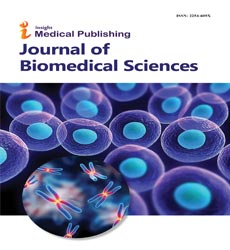A Short Note on Molecular Genetics
Raiden Morino*
Department of Biologocial Sciences, Shizuoka Eiwa Gakuin University, Shizuoka, Japan
- *Corresponding Author:
- Raiden Morino
Department of Biologocial Sciences,
Shizuoka Eiwa Gakuin University, Shizuoka,
Japan
E-mail:morino@shie.ac.jp
Received Date: December 08, 2021; Accepted Date: December 22, 2021; Published Date:December 29, 2021
Citation:Morino R(2021) A Short Note on Molecular Gen etics J Biomed Sci Vol. 10 No. 6:064
About the Study
Genes is a branch of biology that studies genes, hereditary variation, and genetics in living creatures. Even though heredity has been observed for millennia, Gregor Mendel, a Moravian scientist and Augustinian priest working in Brno in the nineteenth century, was the first to investigate genetics scientifically. Mendel researched "trait inheritance," or patterns in how traits are transmitted through the generations from parents to children. Microorganisms (pea plants) acquire features through discrete "units of heredity."
However, the primary rules of genetics are still trait inheritance and molecular inheritance systems of genes, but existing genes have moved beyond inheritance to understand the function and behaviour of genetics. Genetics has spawned a slew of subfields, including molecular genetics, epigenetics, and population genetics. The domains of life (archaea, bacteria, and eukaryotes) are investigated by microorganisms within the broad science of microbiology.
Hereditary processes interact with an organism's environment to influence growth and habits, commonly known as nature vs. nurture. Gene transcription can be turned on or off by the intracellular or extracellular environment of a living cell or organism. Two seeds of genetically identical hammer toe, one growing in a temperate climate and the other in a dry climate, are a classic examples (lacking enough design or rain). While the average height of the two corn stalks may be genetically determined to be comparable, the one in the arid climate typically only grows to half the height of the one in the temperate region due to a lack of regular water and nutrients in its surroundings. Since earlier period, people have used the insight that living things inherit features from their parents to improve crop plants and animals through selective breeding. The present scientific disciplines of genetics, which are attempting to comprehend this process, began with the work of Augustinian friar Gregor Mendel in the mid-nineteenth century.
Although genetics was known to present on chromosomes, chromosomes are made up of both proteins and DNA, and scientists were unaware which of the two would be passed down to future generations. Frederick Griffith discovered the phenomena of transformation in 1928 (see Griffith's experiment): dead germs might pass hereditary material to stillliving germs and "convert" them. The Avery–MacLeod–McCarty experiment, which took place sixteen years later in 1944, found DNA as the molecular transition.
Hämmerling recognised the nucleus' role as a storehouse for genetic information in eukaryotes in 1943 while working on the one-celled alga Acetabularia. The Hershey–Chase experiment in 1952 established that DNA (rather than protein) is the intrinsic substance of the malware that infects bacteria, adding to the growing body of evidence that DNA is the molecule gift of money.
In 1953, James Watson and Francis Crick used Rosalind Franklin and Maurice Wilkins' X-ray crystallography work to establish the content of DNA, which revealed that it has a helical structure. Their double-helix model had two strands of DNA with nucleotides pointing back to the interior, each matching the complementary nucleotide on the other end to create what looked like steps on a twisted ladder.
This structure indicated that genetic information is stored in the nucleotide sequence on each strand of DNA. The structure also indicated a simple replication technique: if the strands are normally separated, new companion strands can be created using the sequence from the old strand. This feature is what gives DNA its semi-conservative nature, which means that one strand of new DNA will be derived from an initial parent strand.
Based on the fact that the structure of DNA indicated how heredity works, it was still unclear how genetics influenced cell behaviour. Researchers spent the next few years trying to figure out how DNA handles the protein-production process. It seems to have been discovered how the mobile uses DNA as a template to generate messenger RNA, molecules containing nucleotides that are remarkably similar to DNA. Your messenger RNA's nucleotide sequence allows you to generate a valine pattern in protein; this type of translation between nucleotide and amino acid sequences is known as the genetic signal.

Open Access Journals
- Aquaculture & Veterinary Science
- Chemistry & Chemical Sciences
- Clinical Sciences
- Engineering
- General Science
- Genetics & Molecular Biology
- Health Care & Nursing
- Immunology & Microbiology
- Materials Science
- Mathematics & Physics
- Medical Sciences
- Neurology & Psychiatry
- Oncology & Cancer Science
- Pharmaceutical Sciences
